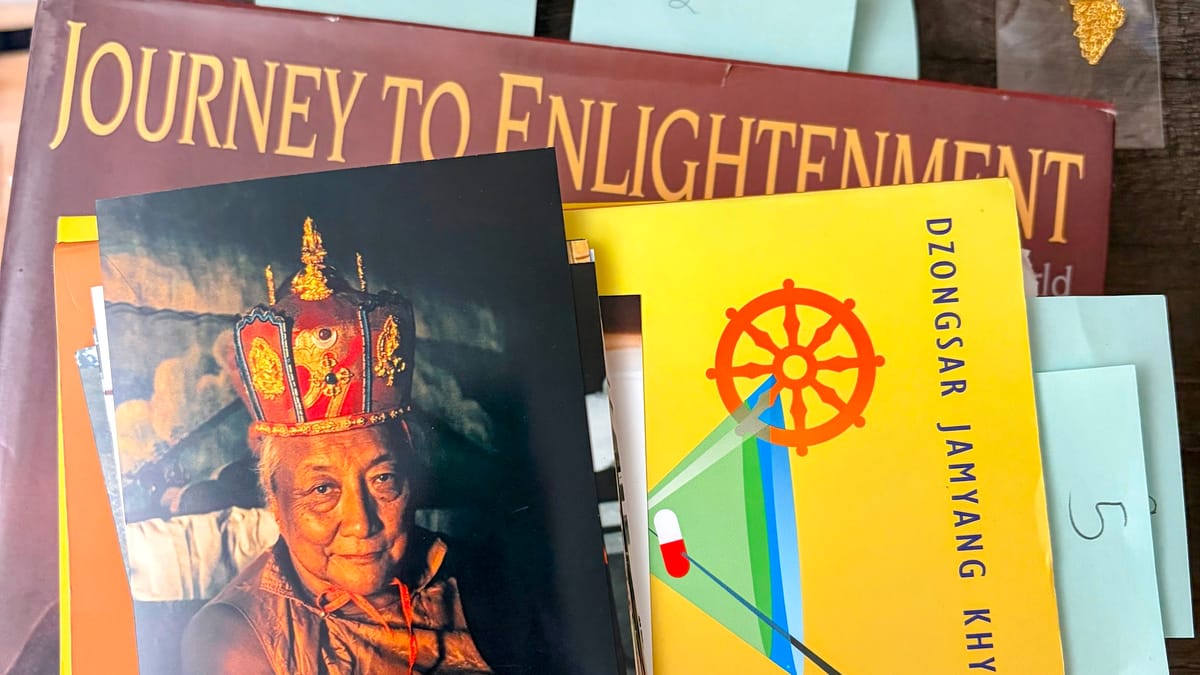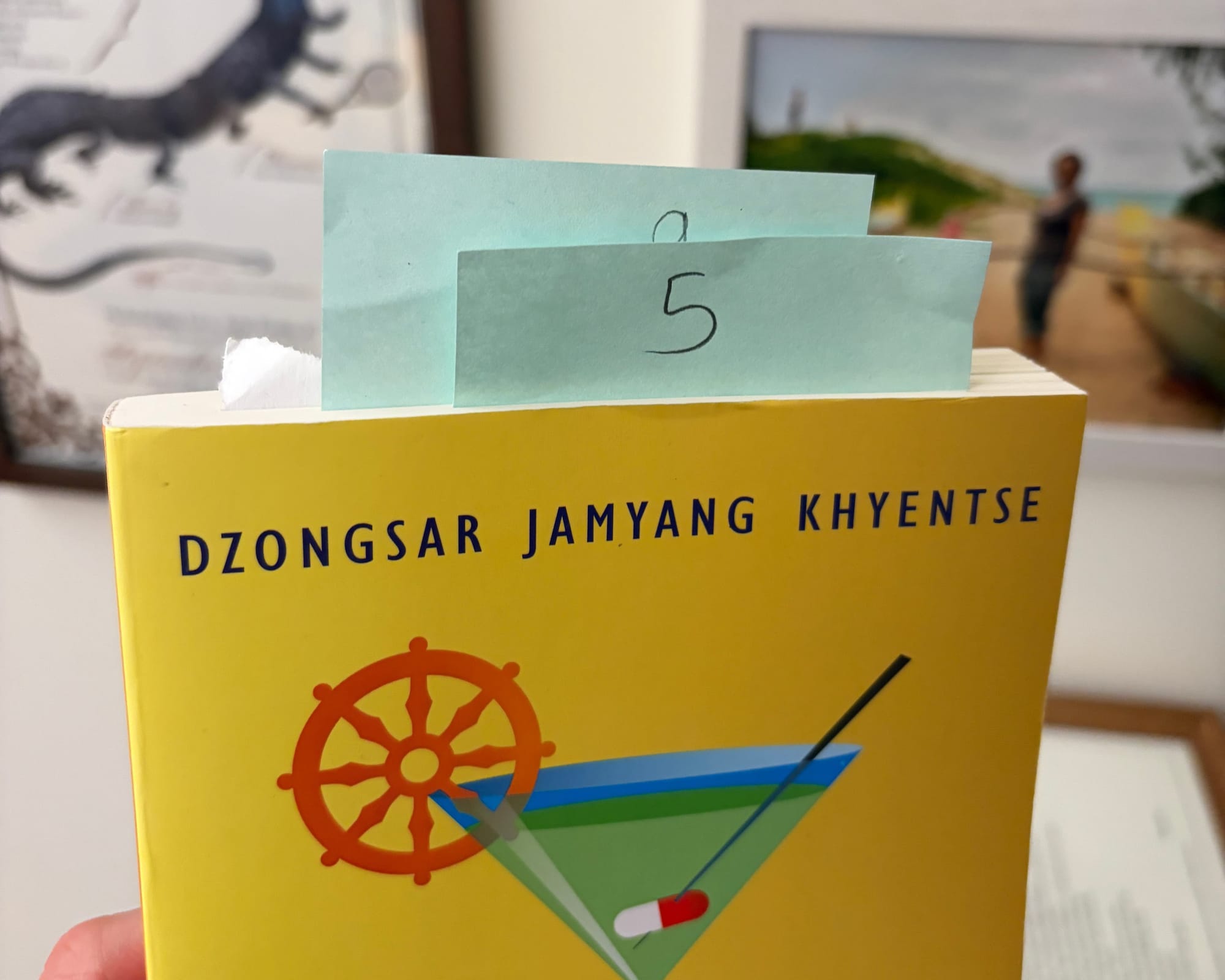Learning to tell stories by telling one
My latest attempt at storytelling - presenting Dilgo Khyentse Rinpoche's influence on American Buddhism using a top-down camera, printed photos, and accepting that anything I said would be inadequate.

I've been hosting The Wisdom Seat's monthly Mindful Gathering for a while now. Usually it's conversations with guests where we discuss a topic. This month I wanted to try something different - actually present something I'd researched. Tell a story about Dilgo Khyentse Rinpoche and how his influence reached American Buddhism and our sangha.
The thing is, Dilgo Khyentse Rinpoche was... immense. Thirteen years in solitary retreat. Escaped Tibet carrying an entire lineage in his memory. Taught for decades across the world. Became head of the Nyingma school. The more I learned about him, the more I thought "how am I supposed to talk about this person?" How am I going to able to say anything worth saying about him??? But, I'd already posted the event and a couple people registered to attend. So...
The preparation part
I re-read three books over a few weeks: Journey to Enlightenment by Matthieu Ricard, and two by Dzongsar Khyentse Rinpoche - The Guru Drinks Bourbon? and Not for Happiness. I took notes on Dilgo Khyentse Rinpoche's life, his teachers, the people he taught. I sketched out a rough timeline from his birth in 1910 through his escape from Tibet in 1959 to his teaching in the West.
I found photos online and in books: images of him as a kid in retreat, with his family, his teachers, teaching Chögyam Trungpa Rinpoche, with his grandson Shechen Rabjam Rinpoche, etc.

The research kept expanding. Since he did so much and preserved so many teachings. I knew I couldn't tell the whole story - this is only a one hour discussion group - so narrowed and picked three narrow aspects: his early years in retreat, his escape and preservation of the lineage, and his specific influence on the teachers who taught our teachers.
To me, that meant accepting that anything I said would be inadequate. Both because he was larger than life, and because I was deliberately choosing a narrow focus.
The format idea
I watch a lot YouTube videos about music equipment - channels like Loopop and Red Means Recording who often put their camera overhead and show whatever they're working on. Top-down view. Simple. Direct. 📷
That made sense for this. I could lay out photos and books and just point to them while talking. No switching between camera and screen share. No fumbling with slides.
As the event date got closer - like, a few days before closer - I started honing in on the quotes I wanted to pull and the photos to show. I printed the photos, and put sticky notes on the book pages I wanted to read from. I used a basic Obsidian note to rough in my script and the points I wanted to hit.
I ended putting in all caps things like SHOW PHOTO 2 for when I wanted to... show photos number 2. Or READ QUOTE 4 and I put a sticky notes on the page to read from with a 4 written so I could find it quickly and read it.

The technical setup
I used my Insta360 Link 2 camera mounted above my desk. It has these preset zoom positions you can program, so I set up three different zoom levels - wide to show my whole desk area, medium for when I was holding up books, tight for when I wanted to focus on a specific photo.

For the mic I used my Rode Video Mic NTG pointed in my general direction about 8" away.
I could click a button on the camera to switch between these presets. Which meant I didn't need to mess with software controls during the presentation.
Also! The recording finally worked this time. In the Insta360 desktop app, you can select an audio input so I selected the Rode mic, and was able to record in 1080p so I didn't have to hope Zoom would record in at least 720p, which it did not. It's like 480p. Gross. 👿
My laptop was off to the side so I could see the Zoom participants. The camera was pointing straight down at my desk where I'd laid out the photos in the order I'd talk about them.
I also had my phone set up to play a clip from a documentary and some audio from our podcast with Shechen Rabjam Rinpoche. Just hit play when I got to that part.
How it actually went
I started by saying out loud what I'd been thinking: "Anything I'm going to say tonight will be inadequate." Partly because of who Dilgo Khyentse Rinpoche was, partly because I was focusing on three specific aspects of a much larger life.
Then I went through it - his early life, the 13 years in retreat, fleeing Tibet, teaching in the West, the connections to our teachers. I held up books, pointed to photos, traced the lineage lines on the paper I'd drawn.
It worked! The top-down view was clear. People could see everything. The zoom presets let me move in and out smoothly. The printed photos were way better than trying to show images on a screen.
Some things were clumsy. I went longer than I meant to on some parts and rushed through others.
But people engaged with it. We had good discussion afterward. Someone asked about the teacher-student relationship in Tibetan Buddhism, which let me read some passages from The Guru Drinks Bourbon? about Dzongsar Khyentse Rinpoche's relationship with his teacher. Another person connected it to their own experience meeting teachers.
The inadequacy I'd worried about? It was there. But it didn't ruin anything. The story was still worth telling, even imperfectly.
What I'm noticing
This was my first time trying to tell a longer story like this, solo, in a first person presentation style. Not just having a conversation or asking someone else questions, but actually presenting information I'd gathered and arranged. This is huge for me. When I started podcasting, and hosting things like this, I needed to have a guest to interview. Interview well is a learned skill, but interviewing at all can be much easier than first person presenting by yourself.
I'm thinking about what made it work (the simple format, the physical photos, the sticky note system) and what I'd do differently (some transitions were clumsy).
Mostly I'm noticing that storytelling is a skill I am actually getting better at. I started to notice I needed this skill two years ago, and slowly I am getting somewhere. Not by planning to do it or thinking about doing it, but by actually setting up a camera and laying out some photos and trying to explain something you find interesting to people who might also find it interesting.
I put the video on YouTube linked at the top of this post.
The resources I used:
- Journey to Enlightenment: The Life and World of Khyentse Rinpoche by Matthieu Ricard https://www.amazon.com/Journey-Enlightenment-Khyentse-Rinpoche-Spiritual/dp/0893816795
- The Guru Drinks Bourbon? by Dzongsar Khyentse Rinpoche https://siddharthasintent.org/publications/the-guru-drinks-bourbon/
- Not for Happiness by Dzongsar Khyentse Rinpoche https://siddharthasintent.org/publications/not-for-happiness/
- Brilliant Moon: The Autobiography of Dilgo Khyentse - both the book and the documentary film https://www.shambhala.com/brilliant-moon-296.html https://youtu.be/ij7x_DGe9X0
- The message of the Tibetans: Buddhism & Tantrism - a 1966 documentary by Arnaud Desjardins that has some of the only footage of Dilgo Khyentse Rinpoche teaching in Tibet before the Chinese invasion https://www.youtube.com/watch?v=z2QVxm1JQek